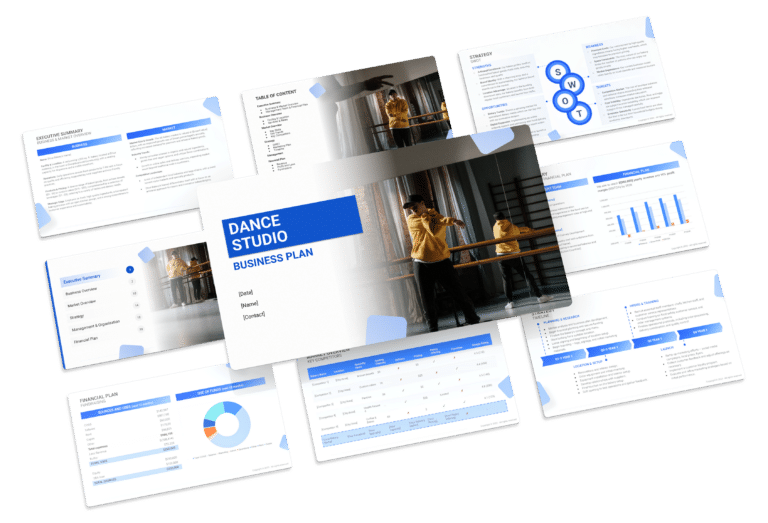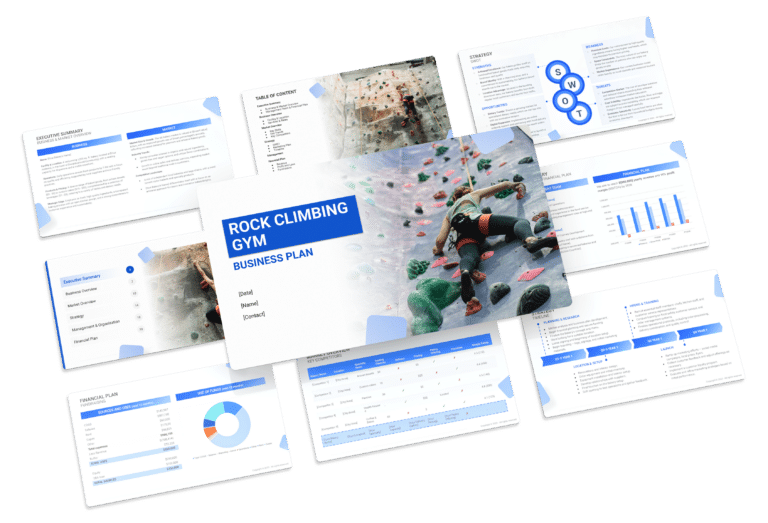Indoor Cycling Studio Business Plan Template & PDF Example

Creating a comprehensive business plan is important for launching and running a successful indoor cycling studio. This plan serves as your roadmap, detailing your vision, operational strategies, and financial forecasts. It helps establish your gym’s identity, navigate the competitive market, and secure essential resources for growth.
This article not only breaks down the critical components of a gym business plan, but also provides an example of a business plan to help you craft your own.
Whether you’re an experienced entrepreneur or new to the fitness industry, we wrote this guide along with an PDF business plan to use as an example to help you prepare a professional business plan for your indoor cycling studio. Let’s dive in!
The Plan
Our indoor cycling studio business plan follows a clear and straightforward structure, covering all the important areas you need in a business plan. It outlines the business operations, its strategy, the market landscape, your key competitors, the management and your financial projections among other things.
Below are the key sections of our business plan:
- Executive Summary: a quick look at your indoor cycling studio’s business, market landscape, management and financial plan.
- Business Overview: detailed info on what your indoor cycling studio offers and its operations:
- Facility, Amenities & Equipment: what your indoor cycling gym looks like, what equipment it has, and its features.
- Location & Accessibility: where your indoor cycling studio is and why it’s a good location for potential customers.
- Memberships & Classes: types of memberships and classes available (as well as prices)
- Market Overview: dives into the fitness market, who are the key competitors in the vicinity and how they compare vs. your business:
- Key Stats: the industry size, growth and some recent important statistics on the indoor cycling industry.
- Key Trends: the recent market trends defining and driving the indoor cycling and/or the studio fitness industry as a whole (regulation, customers trends, etc.)
- Key Competitors: who are your key competitors in the area and how they compare vs. your business.
- Strategy: how the indoor cycling studio plans to grow and attract members:
- SWOT: strengths, weaknesses, opportunities, and threats.
- Marketing Plan: how you intend to attract and retain members / customers.
- Timeline: major steps and goals from starting up to growth (12 months minimum plan)
- Management: who runs the indoor cycling studio and what they do.
- Financial Plan: the expected 5-year financial performance of your indoor cycling studio (revenue and profits), as well as how much you expect to spend.
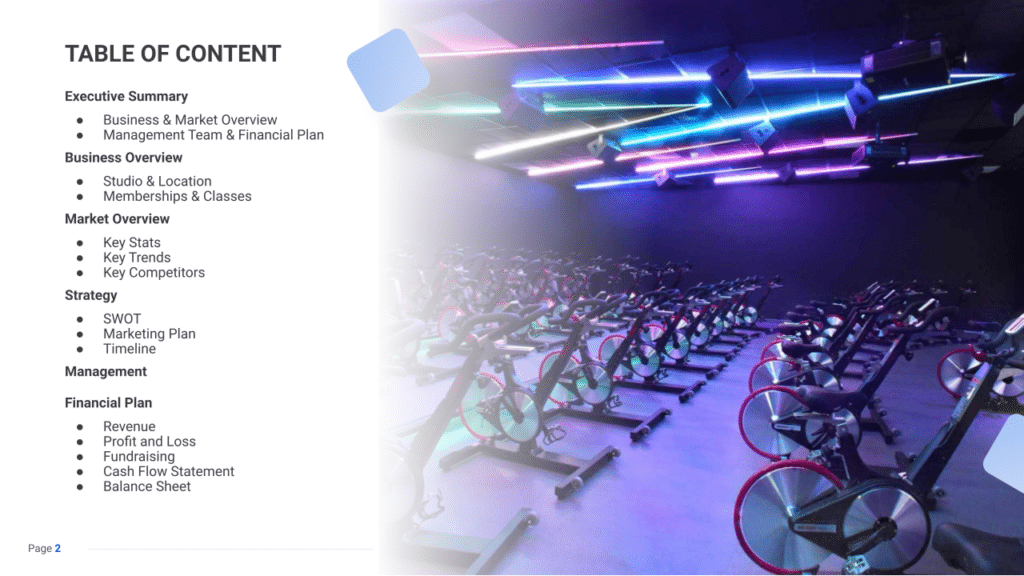
Executive Summary
The Executive Summary introduces your indoor cycling studio’s business plan, offering a brief look at your studio and what it offers. It should cover your positioning, the type of classes and memberships you offer, its location, size and a summary of operations.
This section should also highlight how your indoor cycling studio fits into the broader immediate market (in the area), how many direct competitors you have and who they are, as well as your unique selling points.
Finally, you should also include here details on the management and co-founding team (who they are and what they do), as well as a summary of your financial projections (5-year revenue and profits are enough).
Indoor Cycling Studio Business Plan Executive Summary Example

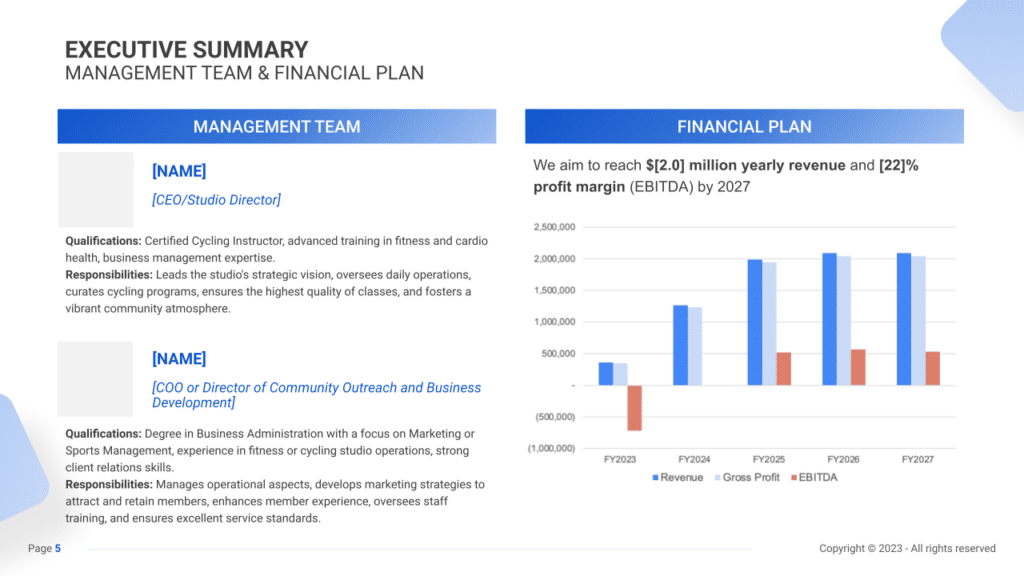
Business Overview
The business overview section of your executive summary lays the foundation by introducing essential details of your indoor cycling studio. It encapsulates fundamental elements such as the studio’s name, strategic location, and operational structure. More importantly, it delves into your unique selling propositions (USPs) that differentiate your studio in the competitive fitness market.
Example:
Cyclone Spin Studio, nestled strategically in the heart of [location], offers an exhilarating assortment of indoor cycling sessions encompassing Classic Rides, Endurance Cycling, Interval Training, and Themed Rides, accommodating diverse fitness levels. Our studio boasts [X,000] sq. ft. of dynamic space, equipped with state-of-the-art stationary bikes, an immersive sound system, and a stimulating ambiance. Additionally, we provide top-notch amenities including changing rooms, showers, and a cozy lounge for post-workout relaxation.
Market Overview
This segment elucidates the market dimensions, growth trajectories, and industry trends shaping the landscape of indoor cycling studios. It provides insight into the US indoor cycling industry’s valuation, growth rates, and competitive arena. Highlighting trends shaping customer preferences within this sphere fortifies your studio’s position within the evolving market.
Example:
The US indoor cycling studio industry, valued at $3.3 billion, experiences rapid expansion with a forecasted +15.2% CAGR from 2022 to 2028, housing approximately 7,000 studios nationwide. Notably, trends favor immersive cycling experiences leveraging technology for virtual landscapes and fostering community camaraderie through group challenges and rides.
Management Team
A robust management team constitutes a pivotal asset for your studio. This section spotlights the key qualifications and experiences of your team members, underscoring their expertise in steering the studio toward success.
Example:
At [Cyclone Spin Studio], our team comprises certified cycling instructors with advanced fitness training, coupled with adept business management skills. Their responsibilities span strategic vision, operational oversight, program curation, and fostering a vibrant community environment, ensuring top-quality classes and exceptional member experience.
Financial Plan
The financial plan offers a concise snapshot of your studio’s financial goals, revenue projections, and strategies for sustainable growth, encapsulating its potential for profitability.
Example:
Cyclone Spin Studio sets ambitious yet achievable financial goals, targeting an annual revenue of $2.0 million and a robust [22]% profit margin (EBITDA) by the year 2027. This aspiration drives our strategic decisions, emphasizing prudent investments, effective marketing, and an unwavering commitment to unparalleled member satisfaction as the core drivers of financial success.
Business Overview
For an Indoor Cycling Studio, the Business Overview in your plan covers 3 main areas briefly:
Facility, Amenities & Equipment
Outline your studio’s layout and the high-quality cycling equipment you offer. Mention any extra features like showers or social areas, focusing on creating an engaging and comfortable environment for members.
Location & Accessibility
Describe the studio’s location, emphasizing convenience and ease of access for your target demographic. Highlight how the location supports easy commutes and fits into the community.
Memberships & Classes
Discuss the variety of classes and membership options available, catering to different schedules and fitness levels. Highlight unique offerings that distinguish your studio from competitors, ensuring flexibility and inclusivity for all members.


Market Overview

Industry Size & Growth
In the Market Overview of your indoor cycling studio business plan, begin by evaluating the current size of the indoor cycling market and its prospects for growth. This assessment will give you a clear picture of the potential customer base and market expansion opportunities.
Key Market Trends
Following this, delve into the recent trends within the market, such as an increasing emphasis on immersive fitness experiences and the popularity of indoor cycling for cardiovascular health and weight management. For example, mention the rise in demand for classes that combine high-energy music with engaging visual elements to enhance the workout experience.
Competitive Landscape
A competitive analysis is not just a tool for gauging your indoor cycling studio’s position in the market; it’s also a fundamental component of your business plan. This analysis helps identify your indoor cycling studio’s unique selling points, essential for differentiating your business in a competitive market.
In addition, competitive analysis is integral in laying a solid foundation for your business plan. By examining various operational aspects of your competitors, you gain valuable information that ensures your business plan is robust, informed, and tailored to succeed in the current market environment.
Identifying Your Indoor Cycling Studio’s Competitors
The first step involves identifying and categorizing your competitors in the fitness industry. Begin by pinpointing other indoor cycling studios in your vicinity. These direct competitors share a similar service offering and target audience. Moreover, consider gyms or fitness centers that offer indoor cycling classes as part of their repertoire. These establishments, although not exclusively dedicated to cycling, still pose a competitive threat.
Leverage online tools like Google Maps to create a geographical overview of competitor locations. Additionally, review platforms like Yelp, Google Reviews, or specialized fitness forums can provide valuable customer insights. For instance, if a rival studio named “Spin & Sweat” garners praise for its energetic instructors and high-intensity classes, this serves as a crucial competitive advantage insight.
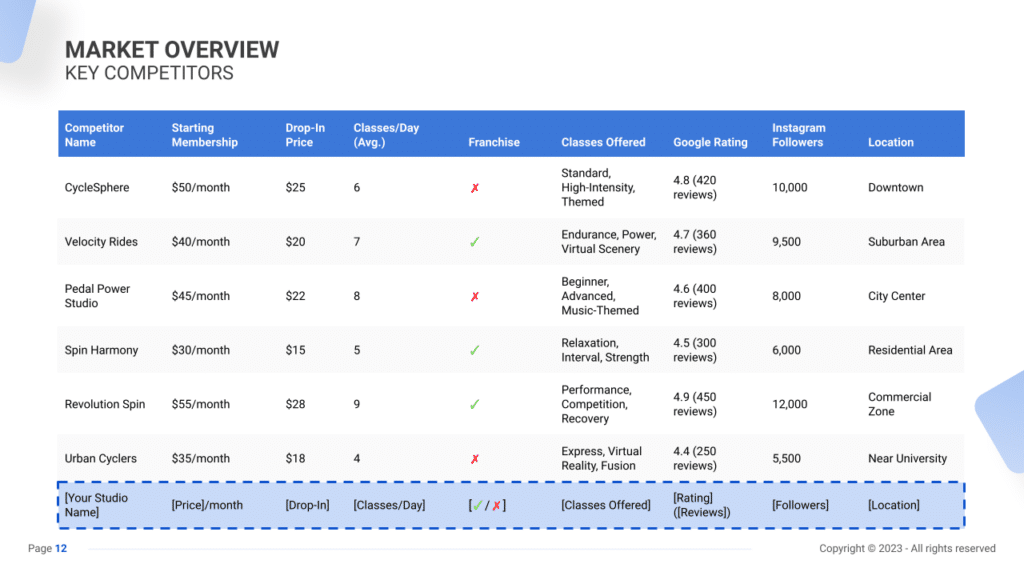
Indoor Cycling Studio Competitor’s Strategies
Analyze various aspects of your competitors’ strategies to gain a comprehensive understanding.
- Class Offerings: Assess the variety and specialization of classes offered. If a competing studio like “Cycle Fusion” emphasizes cross-training with additional strength workouts alongside cycling sessions, this highlights a current trend toward diversified fitness routines.
- Instructor Styles and Expertise: Consider the teaching styles and expertise of instructors. A studio known for celebrity trainers or specialized coaching programs may attract a distinct clientele compared to one emphasizing community-based, inclusive teaching methods.
- Pricing Structure: Compare your pricing strategy against competitors. Are you aligning more with budget-friendly offerings like “Pedal Pushers” or positioning yourself as a premium studio with exclusive amenities akin to “Spin Elite”?
- Marketing and Branding: Scrutinize competitors’ marketing approaches. Are they heavily reliant on social media campaigns, and partnerships with local influencers, or are they more focused on traditional advertising methods?
- Studio Ambiance and Facilities: Evaluate the in-studio experience. A competitor might differentiate itself through state-of-the-art equipment, themed ambiance, or additional services like post-class amenities (showers, refreshments) to enhance the overall customer experience.
- Technological Integration: Observe if competitors are leveraging technology for user convenience. For instance, studios offering online booking, personalized workout tracking, or virtual training sessions cater to modern fitness demands.
What’s Your Indoor Cycling Studio’s Value Proposition?
Define your studio’s unique value proposition in the fitness market. This could revolve around offering specialized training programs like high-intensity interval cycling or incorporating unique themes into classes to create a distinctive workout experience.
Identify gaps in the market through customer feedback and industry trends. For instance, if there’s a rising demand for eco-friendly fitness options and your competitors aren’t addressing this, incorporating sustainable practices could become a unique selling point for your studio.
Consider your location and target audience preferences. An urban studio might emphasize intense, time-efficient workouts, while a studio situated in a suburban area might focus on fostering a sense of community and offering family-oriented packages.
Strategy
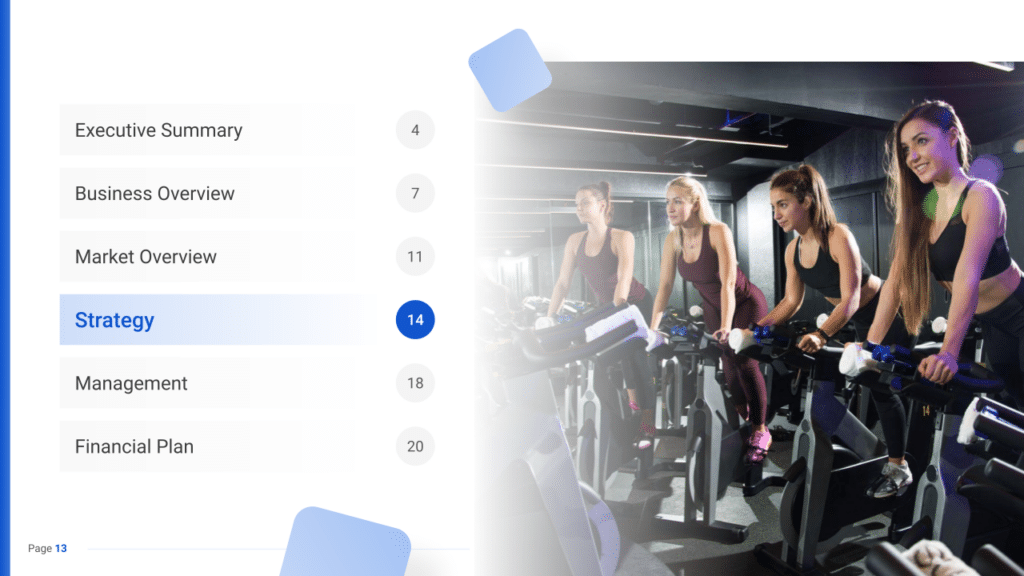
SWOT
First, perform a SWOT analysis to identify the indoor cycling studio’s Strengths (such as state-of-the-art cycling equipment or a central location), Weaknesses (like high startup and operational costs or substantial competition), Opportunities (for example, a surge in interest for indoor cycling within the community), and Threats (such as potential economic downturns impacting customer spending).
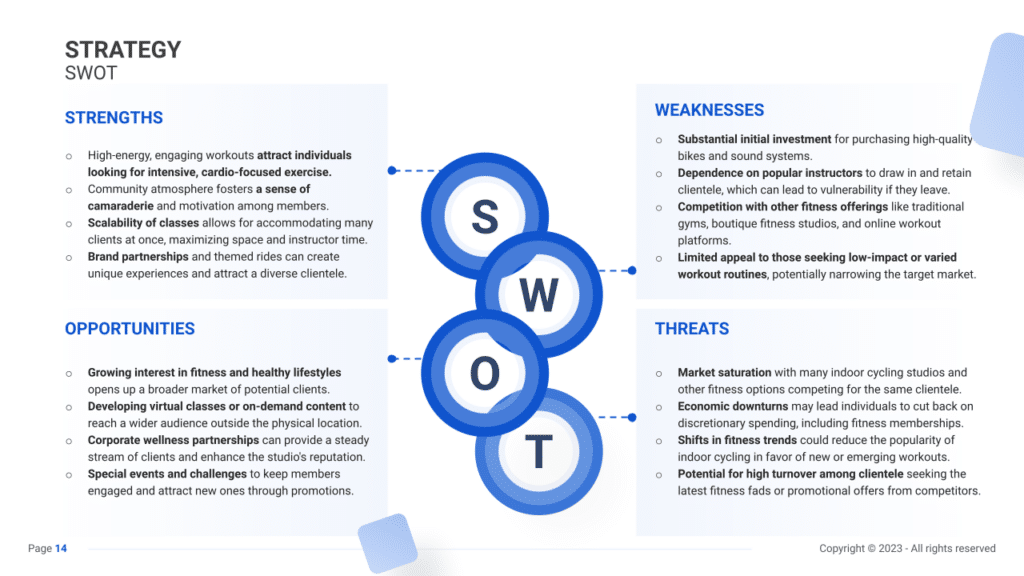
Marketing Plan
Next, devise a marketing strategy that details ways to attract and keep members through targeted advertising, attractive promotions, active social media presence, and participation in local events.
Marketing Channels
Diverse marketing channels play a pivotal role in expanding brand visibility and attracting potential clients to your Indoor Cycling Studio.
Digital Marketing
- Leverage Social Media: Utilize platforms like Instagram for cycling session highlights, Facebook for live workouts, and YouTube for engaging tutorial videos. Regular interaction with your audience is key.
- Email Marketing: Build an email list offering exclusive content, workout schedules, and special session packages. Periodic newsletters featuring fitness tips and updates will maintain engagement.
- SEO and Website Development: A user-friendly website showcasing cycling details, trainer profiles, and informative blog content helps potential clients find your studio online and learn about your offerings.
Local Promotion and Community Engagement
- Offline Advertising: Distribute informative brochures in fitness centers and local cafes—place ads in community magazines or newspapers to reach a broader audience.
- Community Events: Organize free cycling sessions in local parks or participate in fitness expos, offering trial classes or consultations to connect with potential clients.
- Collaborations: Partner with local fitness apparel stores or gyms for joint promotions or combined fitness events.
Promotional Strategies
Implementing effective promotional strategies helps attract new clients and retain existing ones.
- Membership Offers: Introduce various membership plans like unlimited sessions, family packages, or trial periods catering to different client needs.
- Loyalty Programs: Implement rewards such as free workshops or merchandise after a certain number of classes, enhancing customer retention.
- Referral Programs: Encourage current clients to refer friends or family members by offering rewards for successful referrals, effectively increasing your client base.
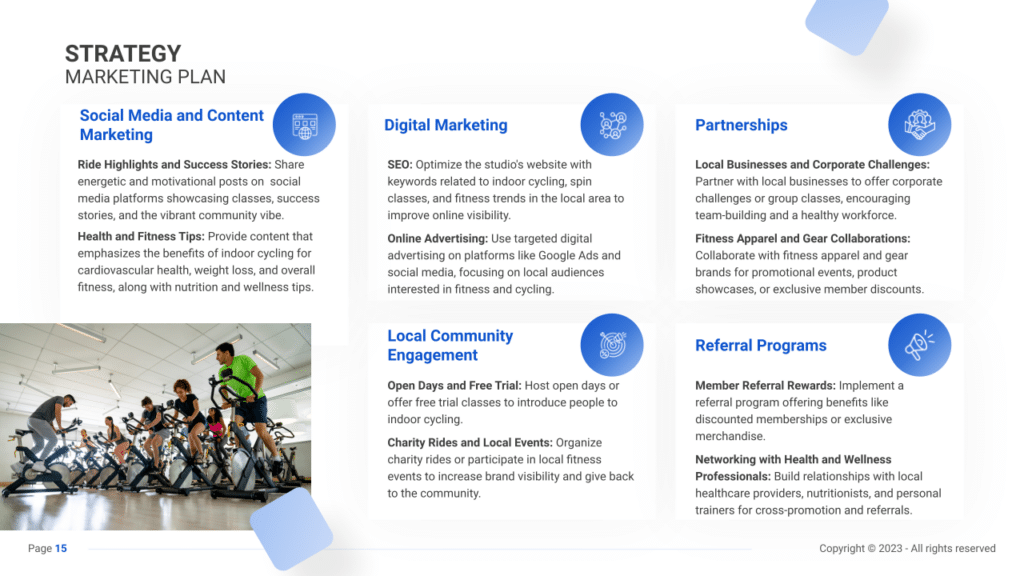
Sales Channels
Efficient sales channels are essential for revenue growth and ensuring client satisfaction.
In-Studio Sales Techniques
- Additional Services: Offer specialized training sessions, personal coaching, or advanced cycling classes to enrich client experiences and increase revenue streams.
- Retail Products: Retail cycling accessories, apparel, and nutrition supplements in your studio to complement clients’ fitness routines and generate additional income.
- Merchandise Display and Upselling: Enhance the in-studio experience by prominently displaying branded merchandise such as cycling apparel, water bottles, towels, and accessories. Train your staff to effectively promote these items during and after classes. Offer bundled deals or discounts on merchandise purchases alongside class sessions to encourage sales.
Online Booking and Membership Sales
- Streamlined Booking: Implement a user-friendly online booking system through your website or app, providing incentives like discounts for online bookings.
- E-Commerce: Sell branded cycling gear, accessories, and gift cards online, broadening your customer reach and sales opportunities.
- Virtual Services: Offer online consultations or cycling sessions for personalized fitness advice, fostering tailored session bookings and product recommendations.
Membership and Loyalty Programs
- Diverse Membership Options: Introduce membership tiers with added benefits like discounts on workshops, guest passes, or exclusive events.
- Loyalty Rewards: Develop digital loyalty programs where clients earn points per session, redeemable for discounts or free sessions, encouraging client loyalty.
Strategy Timeline
Lastly, set a detailed timeline identifying important milestones for the indoor cycling studio’s launch, marketing activities, increase in membership, and goals for scaling up. This approach ensures that the business moves forward with clarity and strategic focus.

Management
The Management section focuses on the gym’s management and their direct roles in daily operations and strategic direction. This part is crucial for understanding who is responsible for making key decisions and driving the gym towards its financial and operational goals.
For your Indoor Cycling Studio business plan, list the core team members, their specific responsibilities, and how their expertise supports the gym’s mission.


Financial Plan
The Financial Plan section is a comprehensive analysis of the Indoor Cycling Studio’s financial plan, including projections for revenue, expenses, and profitability. It lays out the gym’s approach to securing funding, managing cash flow, and achieving breakeven.
This section typically includes detailed forecasts for the first 5 years of operation, highlighting expected revenue, operating costs and capital expenditures.
For your gym business plan, provide a snapshot of your financial statement (profit and loss, balance sheet, cash flow statement), as well as your key assumptions (e.g. pricing strategies for memberships and services, etc.).
Make sure to cover here
_ Profit and Loss
_ Cash Flow Statement
_ Balance Sheet
_ Use of Funds






